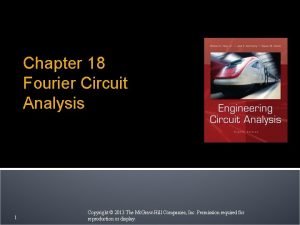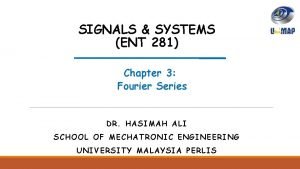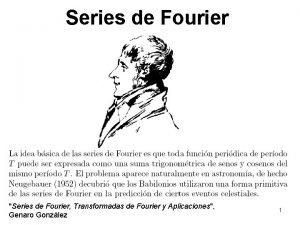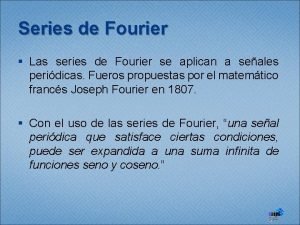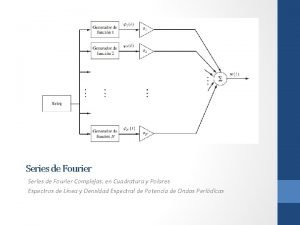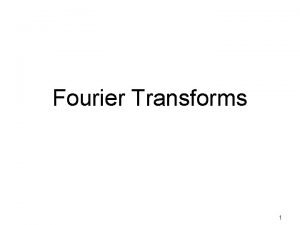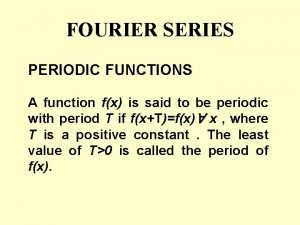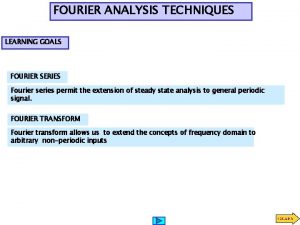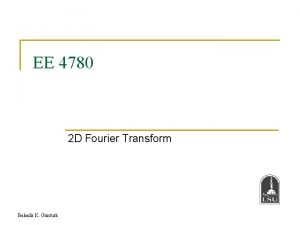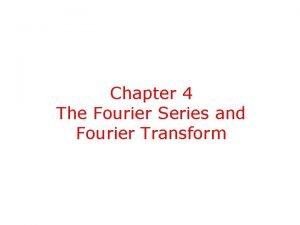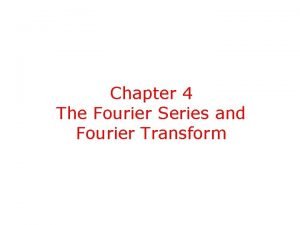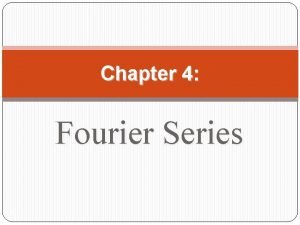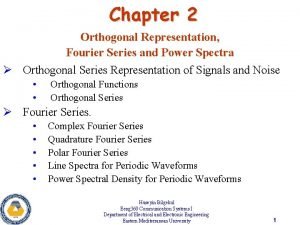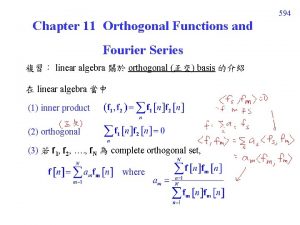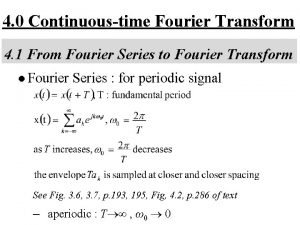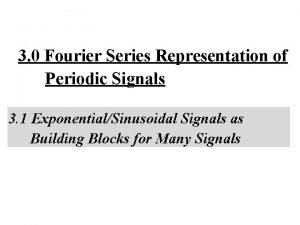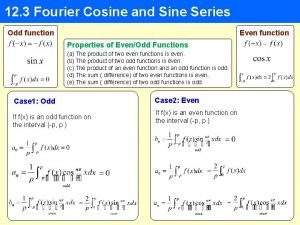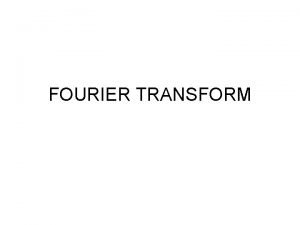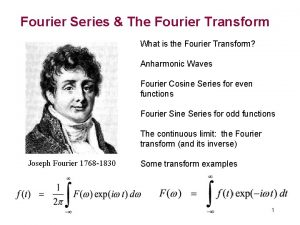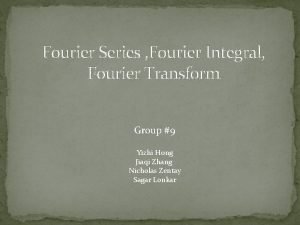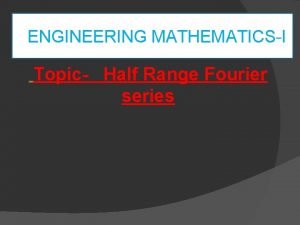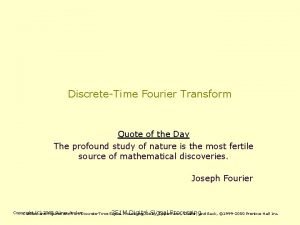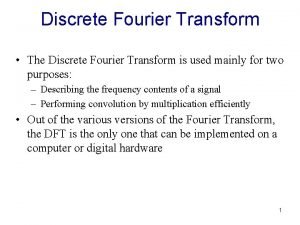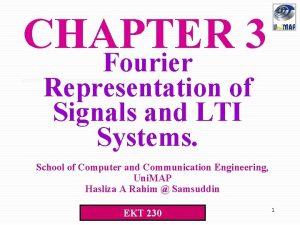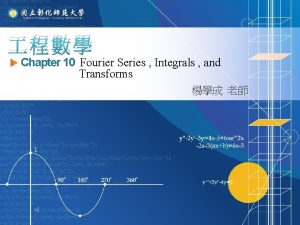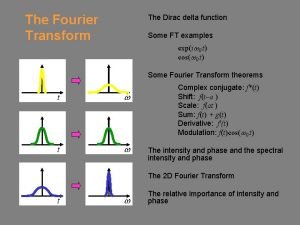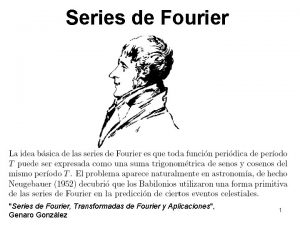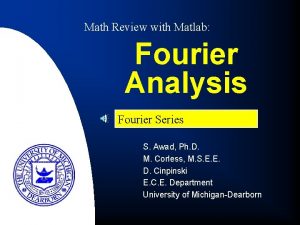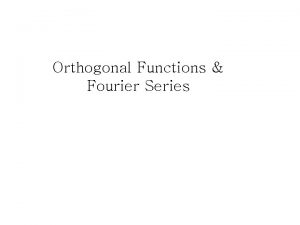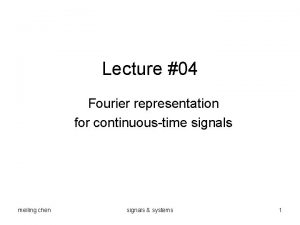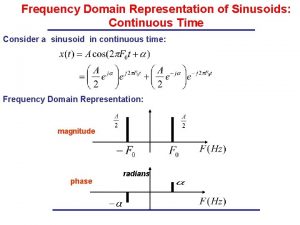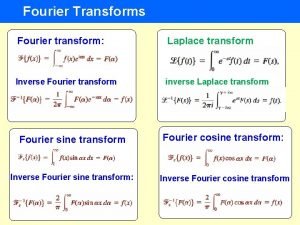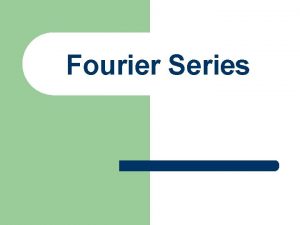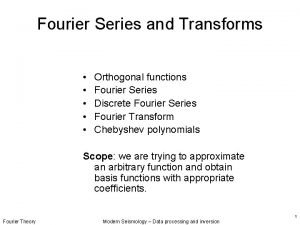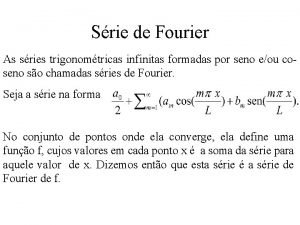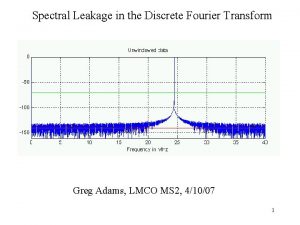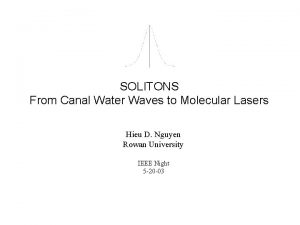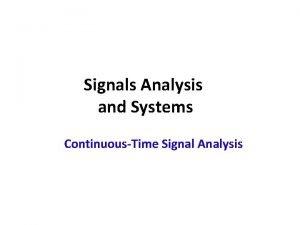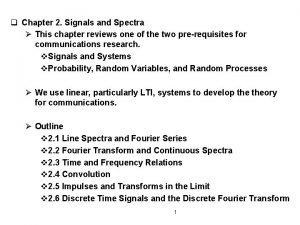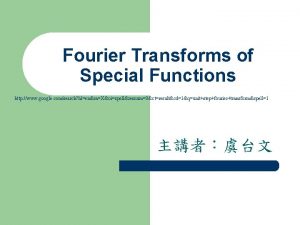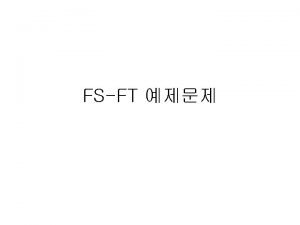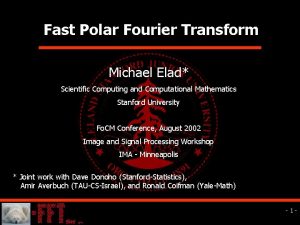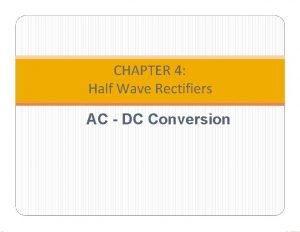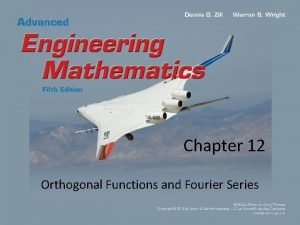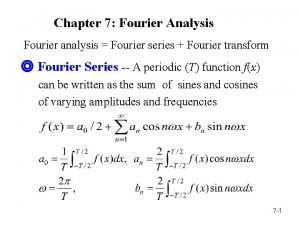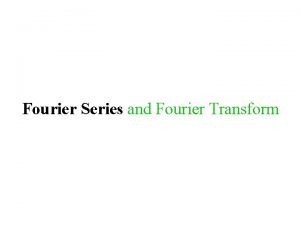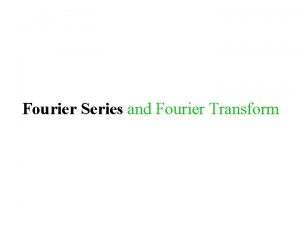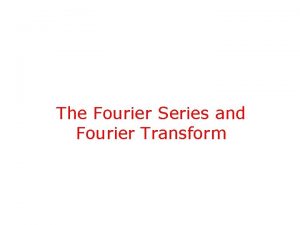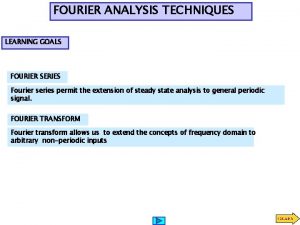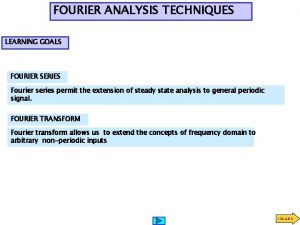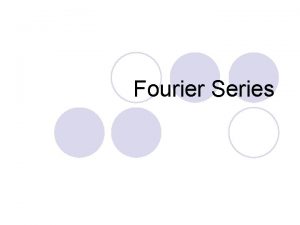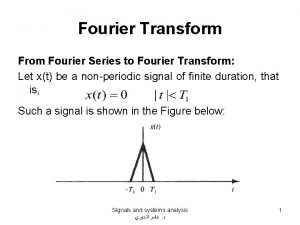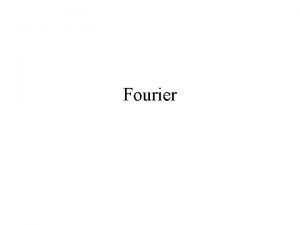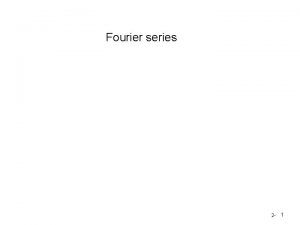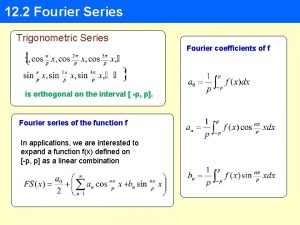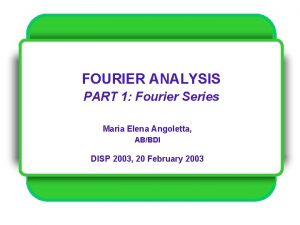Chapter 7 Fourier Analysis Fourier analysis Fourier series

























































- Slides: 57

Chapter 7: Fourier Analysis Fourier analysis = Fourier series + Fourier transform ◎ Fourier Series -- A periodic (T) function f(x) can be written as the sum of sines and cosines of varying amplitudes and frequencies 7 -1

○ Some function is formed by a finite number of sinuous functions 7 -2

Some function requires an infinite number of sinuous functions to compose 7 -3

• Spectrum The spectrum of a periodic function is discrete, consisting of components at dc, , and its multiples, e. g. , For non-periodic functions, i. e. , The spectrum of the function is continuous 7 -4

○ In complex form: Compare with 7 -5

Euler’s formula: 7 -6

7 -7

7 -8

Continuous case 7 -9

◎ Fourier Transform Discrete case: • Vector-Matrix form 7 -10

7 -11

Let 7 -12

。 Example: f = {1, 2, 3, 4}. Then, N = 4, 7 -13

7 -14

7 -15

○ Inverse DFT Let 7 -16

。 Example: 7 -17

◎ Properties ○ Linearity: Show: 7 -18

Application: Noise removal f’ = f + n, n: additive noise It may be easier to identify than n. 7 -19

○ Scaling : Show: Assignment : Show 7 -20

○ Periodicity: 7 -21

7 -22

○ Shifting: 7 -23

。 Example: 7 -24

Compared with: 7 -25

7 -26

◎ Convolution theorem: Convolution: ◎ Correlation theorem Correlation: * : conjugate 7 -27

◎ Fast Fourier Transform (FFT) -- Successive doubling method Let Assume Let N = 2 M. 7 -28

7 -29

Let ----- (B) Consider 7 -30

7 -31


○ Analysis : The Fourier sequence F(u), u = 0 , … , N-1 of f(x), x = 0 , … , N-1 can be formed from sequences u = 0 , …… , M-1 Recursively divide F(u) and F(u+M), eventually each contains one element F(u), i. e. , u = 0, and F(u) = f(x). 7 -33

7 -34

○ Example: Input { f(0), f(1), ……, f(7) } Computing needs { f(0), f(2), f(4), f(6) } even Computing needs { f(1), f(3), f(5), f(7) } odd { f(0), f(4)}, { f(2), f(6) { f(0), f(2), f(4), f(6) } } even odd { f(1), f(3), f(5), f(7) } { f(1), f(5)}, {f(3), f(7) } 7 -35

{ f(0)}, { { f(0), f(4)} even odd { f(1)}, { { f(1), f(5)} { f(2)}, { { f(2), f(6)} even odd { f(3)}, { { f(3), f(7)} Reorder the input sequence into {f(0), f(4), f(2), f(6), f(1), f(5), f(3), f(7)} * Bit-Reversal Rule 7 -36

○ FFT Algorithm 7 -37

7 -38

。 Time complexity : the length of the input sequence FT: FFT: Times of speed increasing: N 4 8 16 32 64 128 256 512 1024 FT 16 84 256 1024 4096 16384 65536 262144 1048576 FFT Ratio 8 24 64 160 384 896 2048 4608 10240 2. 67 4. 0 6. 4 10. 67 18. 3 32. 0 56. 9 102. 4 7 -39

○ Inverse FFT ← Given ← compute i. Input into FFT. The output is ii. Taking the complex conjugate and multiplying by N , yields the f(x) 7 -40

◎ 2 D Fourier Transform ○ FT: IFT: 7 -41

◎ Properties ○ DC coefficient: ○ Separability: 7 -42

7 -43

○ Conjugate Symmetry: F(u, v) = F*(-u, -v) 7 -44

○ Shifting 7 -45

○ Rotation Polor coordinates: 7 -46

○ Display: effect of log operation 7 -47

7 -48

◎ Image Transform 7 -49

◎ Filtering in Frequency Domain ○ Low pass filtering I FT m IFT 7 -50

D=5 D = 30 ○ High pass filtering 7 -51

Different Ds 7 -52

◎ Butterworth Filtering ○ Low pass filter ○ High pass filter 7 -53

○ Low pass filter ○ High pass filter 7 -54

◎ Homomorphic Filtering -- Deals with images with large variation of illumination, e. g. , sunshine + shadows -- Reduces intensity range and increases local contrast ○ Idea: I = LR, L: illumination, R: Reflectance log. I = log. L + log. R low frequency high frequency 7 -55

7 -56

7 -57
 Fourier series circuit analysis
Fourier series circuit analysis Fourier series trigonometric form
Fourier series trigonometric form Seno de 150
Seno de 150 Formulas de fourier
Formulas de fourier Serie de fourier compleja
Serie de fourier compleja Trapezoidal wave fourier series
Trapezoidal wave fourier series Multiplication property of fourier transform
Multiplication property of fourier transform Half range sine series
Half range sine series Find the fourier series of the periodic function
Find the fourier series of the periodic function Fourier series non symmetric interval
Fourier series non symmetric interval Use of fourier series
Use of fourier series Fourier series of impulse train
Fourier series of impulse train Full wave rectified sine wave fourier series
Full wave rectified sine wave fourier series Fourier series formulas
Fourier series formulas Parseval's theorem
Parseval's theorem Fourier series
Fourier series Polar fourier series
Polar fourier series Generalized fourier series
Generalized fourier series Fourier series multiplication property
Fourier series multiplication property Representation of fourier series
Representation of fourier series Fourier sine and cosine series examples
Fourier sine and cosine series examples Fourier transform properties
Fourier transform properties Medical imaging
Medical imaging Inverse fourier transform formula
Inverse fourier transform formula Fourier's theorem
Fourier's theorem Half range fourier series
Half range fourier series Discrete time fourier series
Discrete time fourier series Discrete fourier transform formula
Discrete fourier transform formula Dtft representation of
Dtft representation of Fourier series and integrals
Fourier series and integrals Dirac delta function fourier transform
Dirac delta function fourier transform Series complejas de fourier
Series complejas de fourier Matlab fourier series
Matlab fourier series Series fourier
Series fourier Orthogonal series expansion
Orthogonal series expansion Series de fourier
Series de fourier Frequency-domain
Frequency-domain Fourier series
Fourier series Series de fourier
Series de fourier Series de fourier
Series de fourier Orthogonal functions in fourier series
Orthogonal functions in fourier series Series de fourier
Series de fourier Fourier series coefficients formula
Fourier series coefficients formula Wolfram fourier series
Wolfram fourier series Dirichlet condition of fourier series
Dirichlet condition of fourier series Line spectrum in signals and systems
Line spectrum in signals and systems Inverse fourier transform of unit step function
Inverse fourier transform of unit step function Fourier series
Fourier series Transformata fourier
Transformata fourier Fourier transform in polar coordinates
Fourier transform in polar coordinates Fourier series
Fourier series Fourier series of periodic function
Fourier series of periodic function R load circuit
R load circuit Fourier series and orthogonal functions
Fourier series and orthogonal functions Maclaurin series vs taylor series
Maclaurin series vs taylor series Heisenberg 1925 paper
Heisenberg 1925 paper Serie de taylor
Serie de taylor Taylor series lesson
Taylor series lesson
